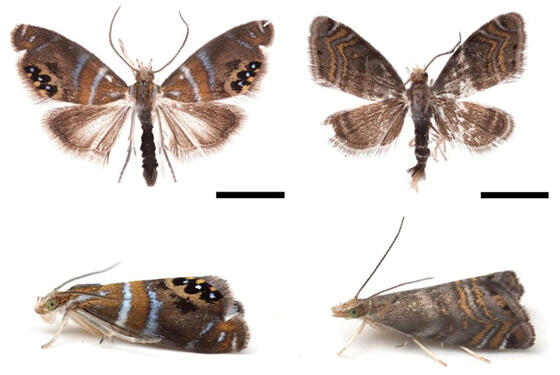The Ogasawara Islands, a World Natural Heritage site, are home to a large number of endemic plants and animals because the islands have never been connected to any other land since their formation. Many species of pyralid moths are known to be endemic to the Ogasawara Islands. In particular, among species of the superfamily Pyraloidea, to which pyralid moths belong, about 25% of those found on the Ogasawara Islands are considered to be endemic species.
A research team led by Academic Researcher Yuki Matsui of the Entomological Laboratory, Faculty of Agriculture at Kyushu University conducted a survey of the moth fauna on the Ogasawara Islands between 2022-2024. They discovered 2 new species of the genus Glaucocharis belonging to the superfamily Pyraloidea on the Ogasawara Islands, which were named Glaucocharis triocellaris (Japanese name: nishiki-eguri-tsutoga) and Glaucocharis plumbofascialis (Japanese name: munin-eguri-tsutoga). The study was published in Zootaxa.

Top left and bottom left: G. triocellaris
Top right and bottom right: G. plumbofascialis. Scales: 2mm
Provided by the Entomological Laboratory of the Faculty of Agriculture at Kyushu University
The genus Glaucocharis has approximately 160 known species worldwide and 7 species in Japan. Spots on the wings and genital morphology of the new species found in this study were clearly distinct from those of other Glaucocharis species, suggesting that the new species have evolved uniquely on the Ogasawara Islands. DNA analysis revealed that the two species are very closely related despite the fact that they appear to be quite different from each other in terms of wing spots and genital morphology.
The two new species found in this study are highly likely to be endemic to the Ogasawara Islands, representing a discovery that enhances the value of the Ogasawara Islands as a World Natural Heritage site. While the endemic species of the Ogasawara Islands have various biogeographic origins, including mainland Japan, the Nansei Islands, and Oceania, DNA analysis results indicate that the two species are not closely related to the Glaucocharis species that originated from Japan. Future research is needed to determine what region they originated from. Furthermore, the two species are completely sympatric, and their larvae both grow by feeding on bryophytes (mosses). Thus, these species may be interesting materials for studying species differentiation patterns in an isolated oceanic island environment.
Matsui said, "Pyralids on the Ogasawara Islands represent a well-studied group, but the new species found in this study have been overlooked until now presumably because both of them measure only about 8 millimeters even when their wings are open. Field research on the Ogasawara Islands is hard, but I believe that many more unknown species can be found if researchers with knowledge of various taxonomic groups conduct surveys."
Journal Information
Publication: Zootaxa
Title: Two remarkable new species of Glaucocharis (Lepidoptera, Crambidae, Crambinae) from the Ogasawara Islands, Japan
DOI: 10.11646/zootaxa.5543.1.4
This article has been translated by JST with permission from The Science News Ltd. (https://sci-news.co.jp/). Unauthorized reproduction of the article and photographs is prohibited.




